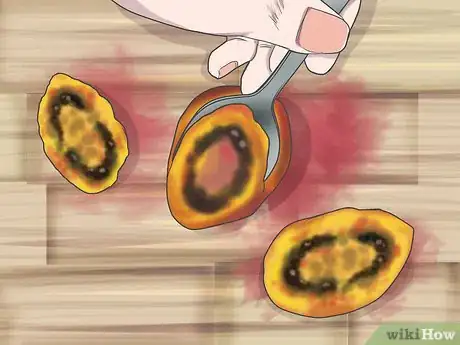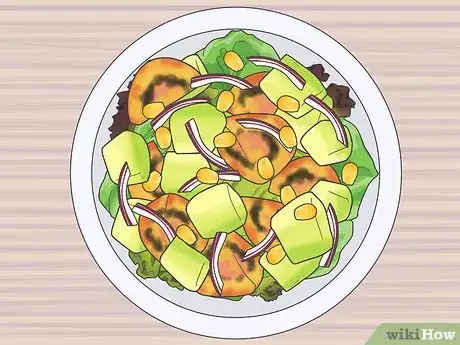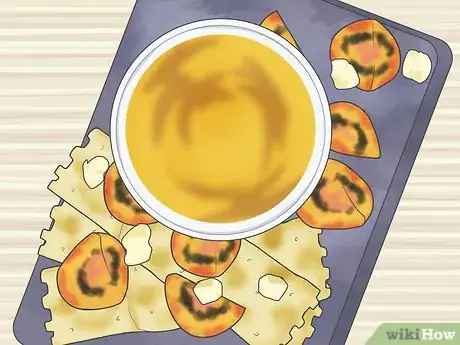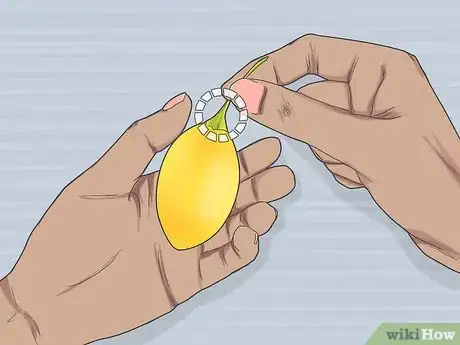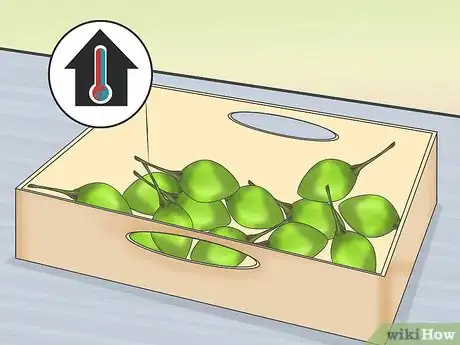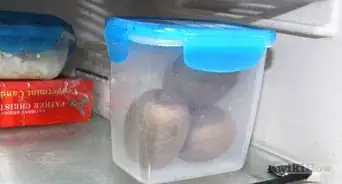This article was co-authored by wikiHow Staff. Our trained team of editors and researchers validate articles for accuracy and comprehensiveness. wikiHow's Content Management Team carefully monitors the work from our editorial staff to ensure that each article is backed by trusted research and meets our high quality standards.
This article has been viewed 33,243 times.
Learn more...
Tamarillos are a type of subtropical fruit with a growing season that mainly spans April through October. Surrounded by an inedible skin, the flesh of the tamarillo fruit is often described as bland, and the pulp is often described as juicy and sweet or tart. Tamarillos can be eaten raw and added to salads or cooked and used in a variety of your favorite dishes. Bon appetit!
Steps
Eating Tamarillos Raw
-
1Cut the tamarillo in half with a knife. The most common way to eat a tamarillo is to first cut the tamarillo in half. Cutting the tamarillo lets you easily get to the flesh behind the inedible skin.
- Be careful when cutting the tamarillo. It would be best to cut it on a non-slip and flat surface.
-
2Scoop the pulp out with a spoon. The pulp inside the tamarillo is similar to the pulp inside tomatoes and is the part of the fruit that's often described as juicy. Since the pulp is softer than the flesh, scooping the pulp out first will make it easier to scrape off the flesh.[1]
- Don't discard the seeds. They are also edible and are very similar to tomato seeds.
- The juices from the tamarillo will stain clothing, so be careful when scooping out the pulp.[2]
Advertisement -
3Scrape off the remaining flesh from the skin. Since the skin of the tamarillo has an unpleasant taste, scooping out the flesh removes the possibility of accidentally eating the skin. Scooping the flesh out is also much more efficient than trying to remove the skin.[3]
Using Tamarillos in Everyday Cooking
-
1Peel the tamarillos to use as an ingredient in cooking. Peeling the skin off the tamarillos makes it easier to use in everyday cooking. Instead of scooping out the flesh, you can more easily cut the tamarillo into slices or into whatever shape a recipe calls for. Here's how to peel tamarillos:
- Put the tamarillos into a bowl and submerge with boiling water for 3-4 minutes.
- Drain the hot water and run the tamarillos under cold water.
- Pinch the tamarillo skin and pull and the skin should come right off.
- If it's difficult to pinch and pull, take a knife and make a small cut first.[4]
-
2Make tamarillos into a sauce. Tamarillos are also known as "tree tomatoes", making them a perfect ingredient for creating a sauce. The sauce can be used with a variety of meats and in a variety of dishes. Here's an example recipe:
- Heat oil in a pan.
- Add 1 large, sliced red onion and cook for around 5 minutes.
- Add the flesh of around 3 tamarillos, 1/4 cup of brown sugar, and 1/2 cup of red wine.
- Bring the mixture to a boil and then reduce the heat to let it simmer for 20 minutes.[5]
-
3Add tamarillos to a salad. Tamarillos can take the place of other fruits such as tomatoes, strawberries, etc. in a salad. You could either remove the skin first and add the tamarillos in slices or cut the tamarillo in half and scoop the flesh into the salad. Tamarillos' tartness works well with a variety of salads so experiment with by adding tamarillos to different salads. These are some ideas for salads to mix with tamarillos
- A tamarillo and avocado salad
- Tamarillos mixed with shredded red cabbage and apple slaw
- A salad with sliced mushrooms and sliced tamarillos
-
4Puree the tamarillos. Pureed tamarillos can be used with a variety of dishes and desserts. Pureeing tamarillos will also make it easier to store and easier to eat. Follow this sample recipe to make a delicious tamarillo puree:
- Take about 12 peeled and sliced tamarillos and boil them in 1/4 cup of water and 1/4 cup of sugar.
- Let the ingredients cook (around 15 minutes) until the tamarillos become very soft.
- Add water as necessary to control the thickness of the puree.
- Pour out and store the puree once you're satisfied with the thickness[6]
-
5Serve tamarillos with cheese and crackers. Tamarillos can be cut into slices or wedges and served alongside a cheese board. Additionally, tamarillos can be a great compliment to crackers; for a sweet-and-salty twist, you can sprinkle some salt onto the tamarillos before serving.
Choosing and Storing Tamarillos
-
1Look for tamarillos that are fully colored in. Most tamarillos are red or golden colored when ripe. Check the tamarillo to see if it's entirely red or golden colored without any splotches of other colors. If it's fully colored, then the tamarillo is likely ripe.[7]
- Red tamarillos are more sour, even when ripe, compared to golden colored tamarillos[8]
-
2Feel the firmness of the tamarillo. You can also determine the ripeness of tamarillos by how firm they feel. If the tamarillo feels slightly soft/squishy, then it is probably ripe or very close to ripe.[9]
-
3Check the color and looseness of the stem. If a tamarillo is ripe, the stem should change color from fully green to slightly yellow. Also, the stem will be slightly loose if the tamarillo is ripe or close to ripe.[10]
-
4Store the tamarillos at room temperature to help them ripen. If the tamarillo you bought isn't fully ripe, leave it at room temperature until it becomes soft. If the tamarillo is already ripe, but you want to save it for later, leaving it in the fridge can prolong its shelf life by around 2 weeks. You could also use the freezer to extend the tamarillo's shelf life even longer.[11]
Community Q&A
-
QuestionWhat are health benefits of tamarillo?
 ClheartCommunity AnswerTamarillo is packed full of vitamins and minerals like vitamins A, C and E, riboflavin, calcium, manganese and many more. They also contain chlorogenic acid, which may help to lower blood sugar levels.
ClheartCommunity AnswerTamarillo is packed full of vitamins and minerals like vitamins A, C and E, riboflavin, calcium, manganese and many more. They also contain chlorogenic acid, which may help to lower blood sugar levels. -
QuestionMy tamarillos are green. Can I eat them like a normal tomato?
 Community AnswerUnripened tamarillos are not palatable to most people. If they are ripe, then yes, you could eat them like a normal tomato. You might prefer them without the skins.
Community AnswerUnripened tamarillos are not palatable to most people. If they are ripe, then yes, you could eat them like a normal tomato. You might prefer them without the skins. -
QuestionTamarillos contain a very hard woody bit inside - what's the best way of locating an removing this before breaking your teeth?
 Community AnswerUse a tool that cleans chile peppers, bell peppers, and tomatoes. It's like an elongated melon baller.
Community AnswerUse a tool that cleans chile peppers, bell peppers, and tomatoes. It's like an elongated melon baller.
Warnings
- The skin of the tamarillo has an extremely unpleasant taste, so avoid eating it.⧼thumbs_response⧽
References
- ↑ https://www.youtube.com/watch?v=l2DXm-aTY6Y
- ↑ https://www.youtube.com/watch?v=l2DXm-aTY6Y
- ↑ https://www.youtube.com/watch?v=l2DXm-aTY6Y
- ↑ http://www.tamarillo.com/peeling/
- ↑ https://www.healthyfood.co.nz/healthy-recipes/pork-with-tamarillo-sauce
- ↑ http://www.teoranga.co.nz/Tamarillorecipetwo.htm
- ↑ http://www.tamarillo.com/selection/
- ↑ http://www.teoranga.co.nz/Tamarillorecipetwo.htm
- ↑ http://www.tamarillo.com/selection/

